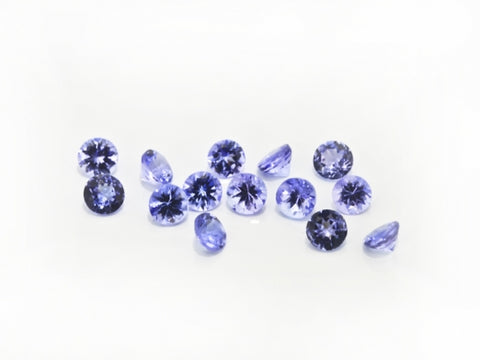Your Cart is Empty

December’s birthstones offer three choices: tanzanite, zircon and turquoise – all of them, appropriately, best known for beautiful shades of blue.
These gems range from the oldest on earth (zircon), to one of the first mined and used in jewelry (turquoise), to one of the most recently discovered (tanzanite).
All of these stones are relatively inexpensive, but their beauty rivals even precious gems. Colorless zircon is a convincing replacement for diamond, tanzanite often substitutes sapphire, and turquoise is unmatched in its hue of robin’s egg blue.

TANZANITE
Tanzanite is the exquisite blue variety of the mineral zoisite that is only found in one part of the world. Named for its limited geographic origin in Tanzania, tanzanite has quickly risen to popularity since its relatively recent discovery.
Zoisite had been around more than a century and a half before this rare blue variety was found in 1967. Trace amounts of vanadium, mixed with extreme heat, cause the blue color – which ranges from pale blue to intense ultramarine with violet undertones.
Due to pleochroism, tanzanite can display different colors when viewed from different angles. Stones must be cut properly to highlight the more attractive blue and violet hues, and deemphasize the undesirable brown tones.
Tanzanite is still only found on a few square miles of land in Tanzania, near majestic Mount Kilimanjaro. Its price and availability are directly tied to mines in this region.
Tanzanite measures 6.5 to 7 on the Mohs scale of hardness – which is not nearly as hard as the sapphire it often substitutes. Given its vulnerability to scratch during daily wear and abrasion, tanzanite is better suited for earrings and pendants than rings. (https://www.americangemsociety.org/en/tanzanite-overview)
ZIRCON
Zircon is an underrated gem that’s often confused with synthetic cubic zirconia due to similar names and shared use as diamond simulants. Few people realize that zircon is a spectacular natural gem available in a variety of colors.
The name zircon likely comes from the Persian word zargun, meaning “gold-colored.” Others trace it to the Arabic zarkun, meaning “vermillion.” Given its wide range of colors – spanning red, orange, yellow, green, blue and brown – both origins make sense.
Zircon commonly occurs brownish red, which can be popular for its earth tones. However, most gem-quality stones are heat treated until colorless, gold or blue (the most popular color). Blue zircon, in particular, is the alternative birthstone for December.
Color differences in zircon are caused by impurities, some of which (like uranium) can be slightly radioactive. These gems are also treated with heat to stabilize the radioactivity.
While radiation can break down zircon’s crystal structure, it plays a crucial role in radiometric dating. Zircon, the oldest mineral on earth, contains important clues about the formation of our planet.
Colorless zircon, known as Matura Diamond, displays brilliance and flashes of multicolored “fire” that can rival fine diamond. There’s one key difference though: Zircon is more brittle. Though it measures 7.5 on the Mohs scale of hardness, its faceted edges can chip.
Zircon from Australia dates back 4.4 billion years. Australia still leads the world in zircon mining, producing 37 percent of the world’s supply. Other sources include Thailand, Sri Lanka, Tanzania, Cambodia, Canada and the United States. (https://www.americangemsociety.org/en/zircon-overview)
TURQUOISE
Admired since ancient times, turquoise is known for its distinct color, which ranges from powdery blue to greenish robin’s egg blue. It’s one of few minerals to lend its name to anything that resembles its striking color.
The word turquoise dates back to the 13th century, drawing from the French expression pierre tourques, which referenced the “Turkish stone” brought to Europe from Turkey.
Ancient Persia (now Iran) was the traditional source for sky blue turquoise. This color is often called “Persian blue” today, regardless of its origin. The Sinai Peninsula in Egypt was also an important historical source.
The U.S. is now the world’s largest turquoise supplier. Nevada, New Mexico, California and Colorado have produced turquoise, but Arizona leads in production by value, as well as quality. The stone’s popularity here makes it a staple in Native American jewelry.
Turquoise is found in arid regions where rainwater dissolves copper in the soil, forming colorful nodular deposits when it combines with aluminum and phosphorus. Copper contributes blue hues, while iron and chrome add a hint of green.
Some turquoise contains pieces of host rock, called matrix, which appear as dark webs or patches in the material. This can lower the stone’s value, although the uniform “spiderweb” pattern of Southwestern turquoise is attractive.
Turquoise is sensitive to direct sunlight and solvents like makeup, perfume and natural oils. The hardest turquoise only measures 6 on the Mohs scale, which made this soft stone popular in carved talismans throughout history.
From ancient Egyptians to Persians, Aztecs and Native Americans, kings and warriors alike admired turquoise for thousands of years. It adorned everything from jewelry to ceremonial masks to weapons and bridles – granting power and protection, particularly against falls. (https://www.americangemsociety.org/en/turquoise-overview)
The above gemstones (or similar) are available for creating that extra special heirloom piece. Contact Sarah to view the stones and to discuss potential designs and pieces for yourself or someone special.
Comments will be approved before showing up.